
There are many factors that go into picking the right kitchen sink for your project. You’ll want to consider the ideal material, color, style, and more when sorting through the incredible number of sinks on the market today. However, before you get ahead of yourself, the first factor to nail down is the ideal sink size for the cabinet you already have in place or plan to purchase. It’s necessary to pick the correct sink size based on your cabinet so everything will fit together nicely when all is said and done.
The good news here is this – figuring out the right sink size for your cabinet is actually pretty simple. It does require a basic understanding of how sinks are installed in cabinets, however, so we’ll walk through the details step by step in this article, making sure you have a clear picture by the time we are finished. In the end, you should feel ready to order a beautiful sink with confidence, knowing you have picked precisely the right size for your application. Let’s get started!
The Quick Version
Throughout the rest of this article, we are going to dive into the details of how cabinets and sinks are measured, what factors to consider, and how to determine if a particular sink will fit in your cabinet. However, if you’d like to get right to the bottom line so you can place an order and get your project moving, this set of bullet points is for you.
- To determine what size sink you can use in your kitchen, you first need to know the dimensions of the base cabinet where the sink will live. Common widths include 24’’ and 36’’, but take measurements or check your cabinet order to confirm what you have to work with.
- The “length” of a sink is the most important dimension, as this is the space it will need from side to side within the cabinet. The length of the sink you order needs to be less than the width of the interior of the cabinet, with a little room to spare. For example, 36’’ wide cabinets are often outfitted with 33’’ sinks.
- It’s important to know how the sink will be mounted, with drop-in and undermount sinks being the two most popular options. A drop-in sink will leave the rim on the top of the counter, while the rim will need space under the counter (within the cabinet) when doing an undermount installation.
- The other sink dimensions are important to check on as well – width and depth – but they are unlikely to cause any problems unless your counters or cabinets are of an unusual size.
So, the key when ordering a kitchen sink is to keep the length of that sink within the parameters offered by your base cabinet. Knowing the width of the interior of that cabinet will let you order with confidence, as long as you check the specs on the sink carefully before confirming your choice. For much more detail and discussion on this topic, please read on.
An Introduction to Kitchen Sinks
Despite using your kitchen sink day after day for most of your life, you might not know much about how these sinks are sized or how they are installed. The first step in your education is to talk about the different types of kitchen sinks and what that means for their measurement and installation in your kitchen. To get started, let’s introduce you to the three most common types of kitchen sinks used in new construction and remodeling projects.
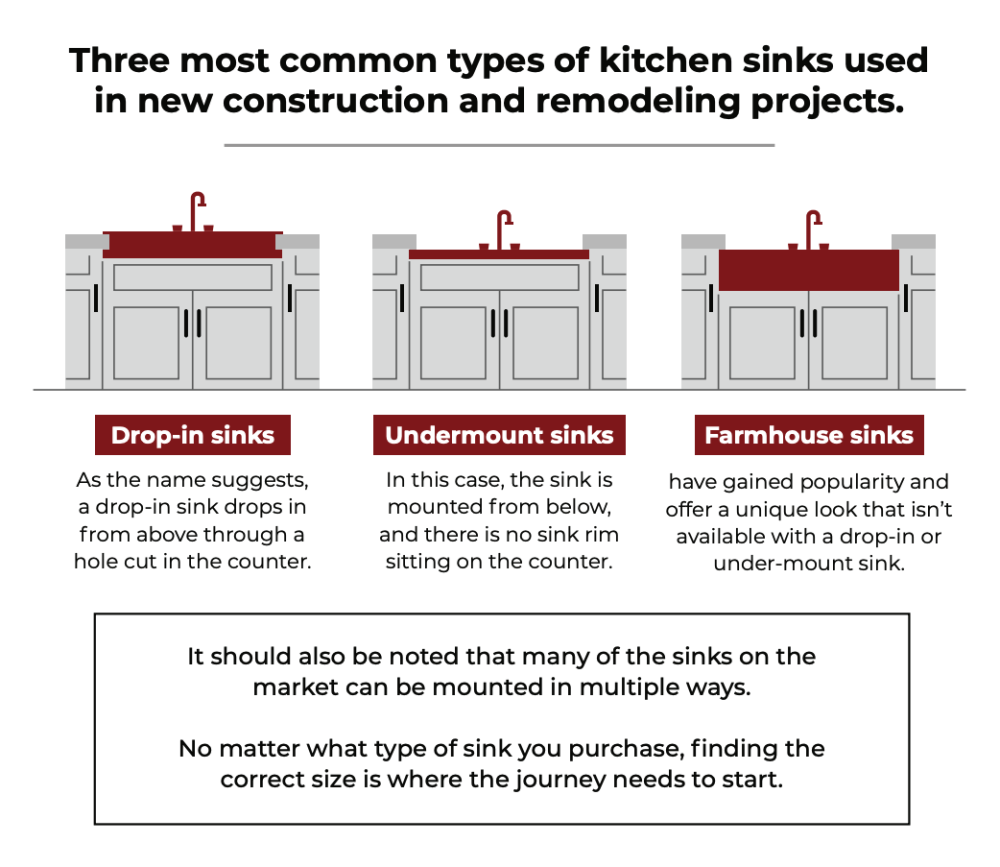
- Drop-in sinks. As the name suggests, a drop-in sink is one that drops in from above through a hole that has been cut in the counter. This is the most popular type of kitchen sink, and it’s immediately recognizable thanks to the rim that runs around the top. That rim sits on the counter and allows the sink to be secured in place. We’ll talk much more about sizing later, but it can be noted at this time that a drop-in sink needs to be the right size to both fit within the cabinet and also to catch on the counter, so it doesn’t fall all the way through. Matching up the sink you purchase with the hole in your countertop is the most important task you face when placing an order for a new sink.
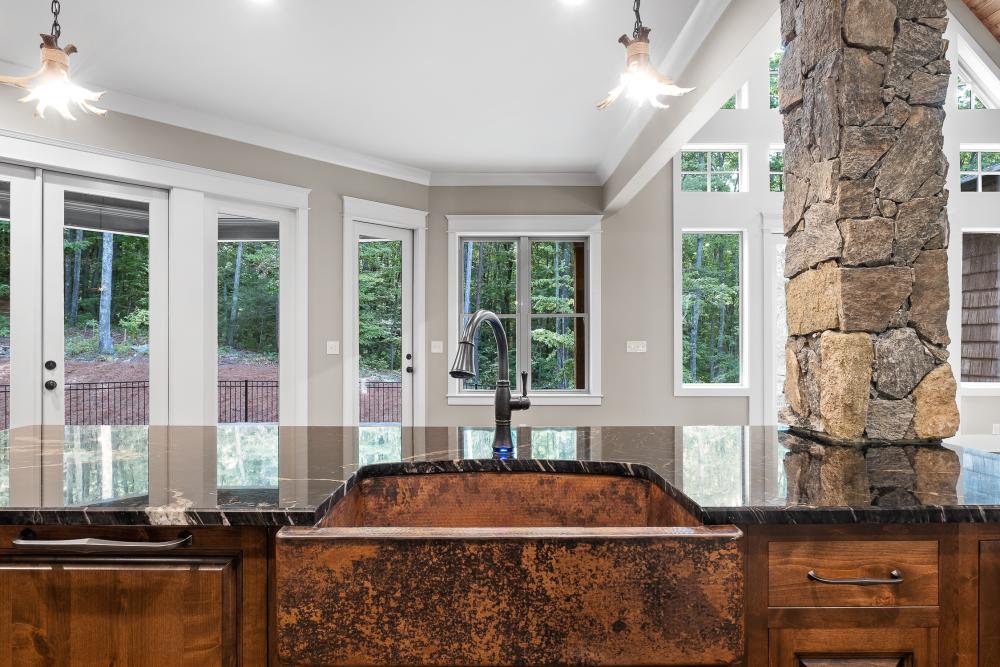
- Undermount sinks. In this case, the sink is mounted from below, and there is no sink rim sitting on the counter. Some homeowners love the modern look that these types of sinks provide, as you are left with a clean counter lip right down into the sink basin. An undermount sink is most often going to be used along with a solid stone counter of some kind. In terms of sizing, again the sink needs to match up with the opening in the counter and not be too big for the cabinet as a whole. Since it mounts below, you’ll need room around the sink opening for the rim of the sink to be attached firmly into place.
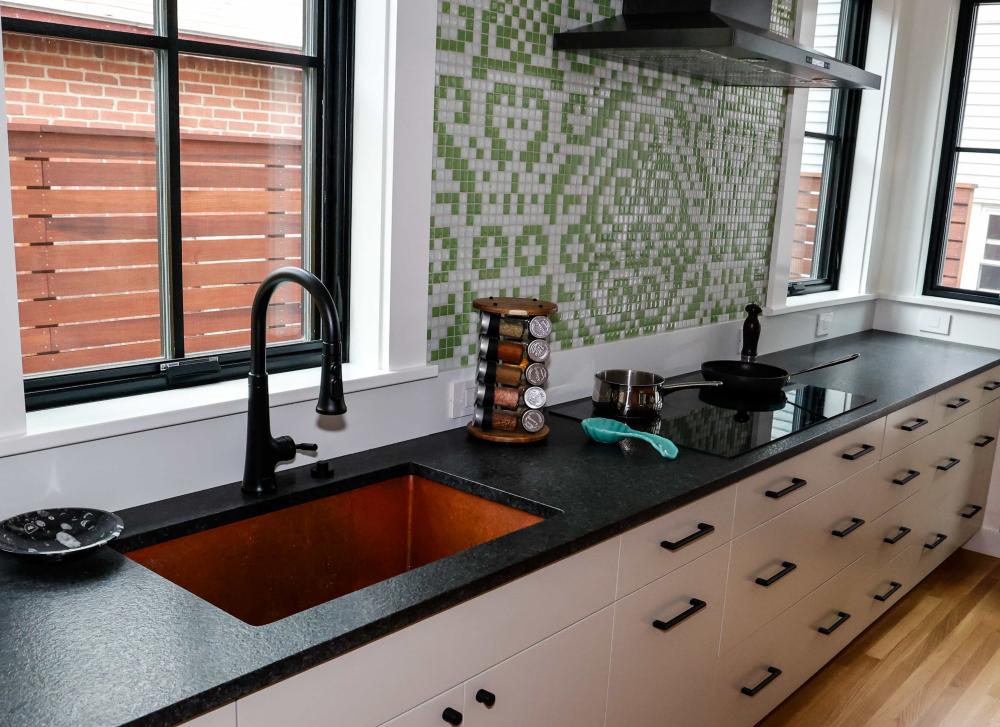
- Farmhouse sinks. This style of sink is not as common as the first two, so we will focus mostly on those in the article below. It’s worth mentioning farmhouse sinks, however, as they have gained in popularity and offer a unique look that isn’t available with a drop-in or undermount sink. In this case, the front of the sink is actually exposed through the cabinet, allowing you to see whatever material the sink is made from after it is installed. There is some more complicated cabinet work involved here to make room for the sink, which is part of the reason that these are not used more frequently.
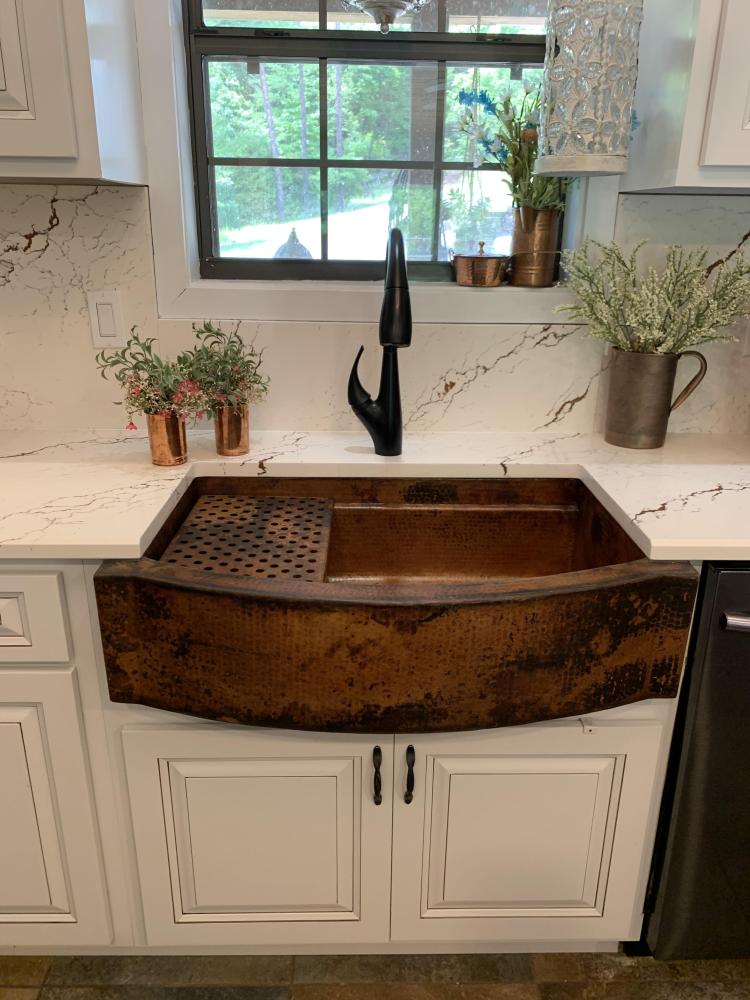
Of course, there are plenty of other sinks on the market, many of which fall into a sub-category of those we have discussed above. For example, you’ll find both single basin and double basin sinks as you shop, and those can be included in either the drop-in or undermount categories. It's important to note that each sink can be made to be a workstation.
It should also be noted that many of the sinks on the market have the option to be mounted in multiple ways. So, you might find a sink that can be mounted as either a drop-in or undermount model, depending on your preference. In that case, you’ll simply need to double-check the dimensions on the sink and compare those measurements to your cabinet to make sure it is going to fit based on your desired installation method. We’ll talk more about how sinks are measured later in this article.
No matter what type of sink you choose to purchase, finding the correct size is where the journey needs to start, and we’ll get deeper into that discussion in the next section.
The Relationship Between Sink and Counter
In the title of this article, we pointed to the cabinet as a key factor that you will need to consider when selecting the right sink size. And, to be sure, the cabinet is an important factor – but it’s not the only thing to consider. There is also the kitchen counter to think about, as the sink will have to “play nice” with the counter for your installation to be a success.
If you are buying a new kitchen sink to replace an old one in an existing counter, the job will be pretty easy. You can simply take the measurements from your old sink and use those to find a new one (more on how to measure a sink later). Also, you’ll want to look in the same category of sink that you are replacing, so you’ll want to replace a drop-in with a drop-in, an undermount with an undermount, etc. Since the counter is already prepared for that type of installation, you’ll want to match up the new to the old so there aren’t any problems. It is worth noting that you could easily switch types of sinks within the same category, such as getting a double-basin drop-in sink to replace the single-basin drop-in that you removed.
Should you be working on a project where you’ll be replacing an old sink with a new sink in an existing counter, there are a couple of other sizing points to keep in mind:
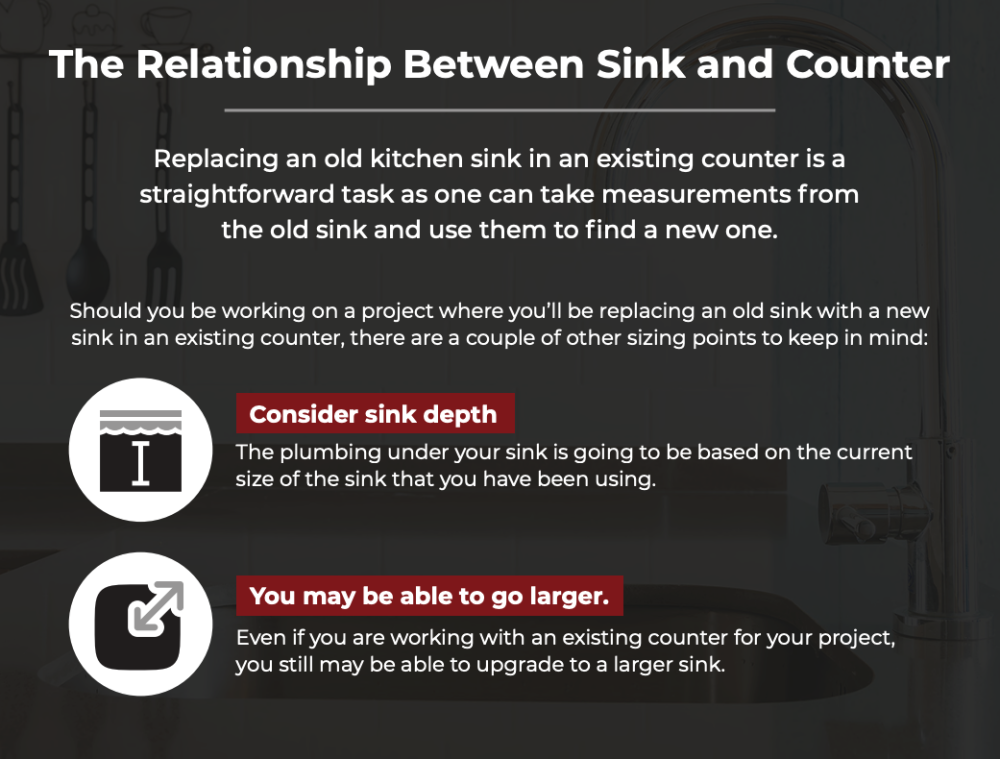
- Consider sink depth. The plumbing under your sink is going to be based on the current size of the sink that you have been using. If you opt for a deeper sink, for example, the plumbing is going to have to be adjusted accordingly. That’s not a particularly big deal, but it is something to keep in mind. If you aren’t comfortable or experienced doing basic plumbing work on your own, bringing in a professional to finish the job may be necessary.
- You may be able to go larger. Even if you are working with an existing counter for your project, you still may be able to upgrade to a larger sink. For example, if you have taken out a sink that is 30’’ long, and you want to buy one that is 33’’ long, that could be a viable option. However, there are two points to keep in mind if attempting this switch. First, you need to make sure the underlying cabinet is large enough to accommodate this bigger sink. If there isn’t enough width available in the cabinet, you won’t be able to go for the bigger sink, even if there is room on the counter. Also, remember that you are going to have to create a larger hole in the counter to suit the new sink. Depending on the material that makes up your counter, enlarging the hole could be a simple project – or it could be quite a challenge. This is another area where you need professional help if you don’t have the tools and know-how to do it on your own.
The only time you need to think much about the counter as part of this project is when replacing an old sink and using the same counter. If you’ll be putting new counters as part of a whole new kitchen project, you can simply have the counter cut to fit the sink you choose – so it’s a non-factor. In that case, your primary concern is the size of the cabinet that the sink is going to rest in, and we’ll be talking about that more in the rest of this article.
Getting to Know Your Cabinets
Picking a sink of the right size for your kitchen project requires getting familiar with the cabinets that you’ll be having installed. Sure, you probably spend plenty of time deciding how the cabinets will look, and how many of them there will be, but you might not have carefully looked at the dimensions until now. In general, you don’t really need to know the dimensions of most of your cabinets. As long as they are big enough to fit your plates, bowls, glasses, etc., you are good to go.
The cabinet that will be home to your kitchen sink is different, however. In this case, you do need to know how big the cabinet is, as those dimensions will put a hard limit on the size of sink you can select. Simply put, a sink that is bigger than the cabinet you have to work with won’t fit, and you’ll have to send it back. To avoid that frustrating outcome, get your measurements dialed in upfront and pick a sink that will work without any trouble.
So, what measurements should you be taking when evaluating how much sink you can fit in your cabinet? There are three main numbers to identify.
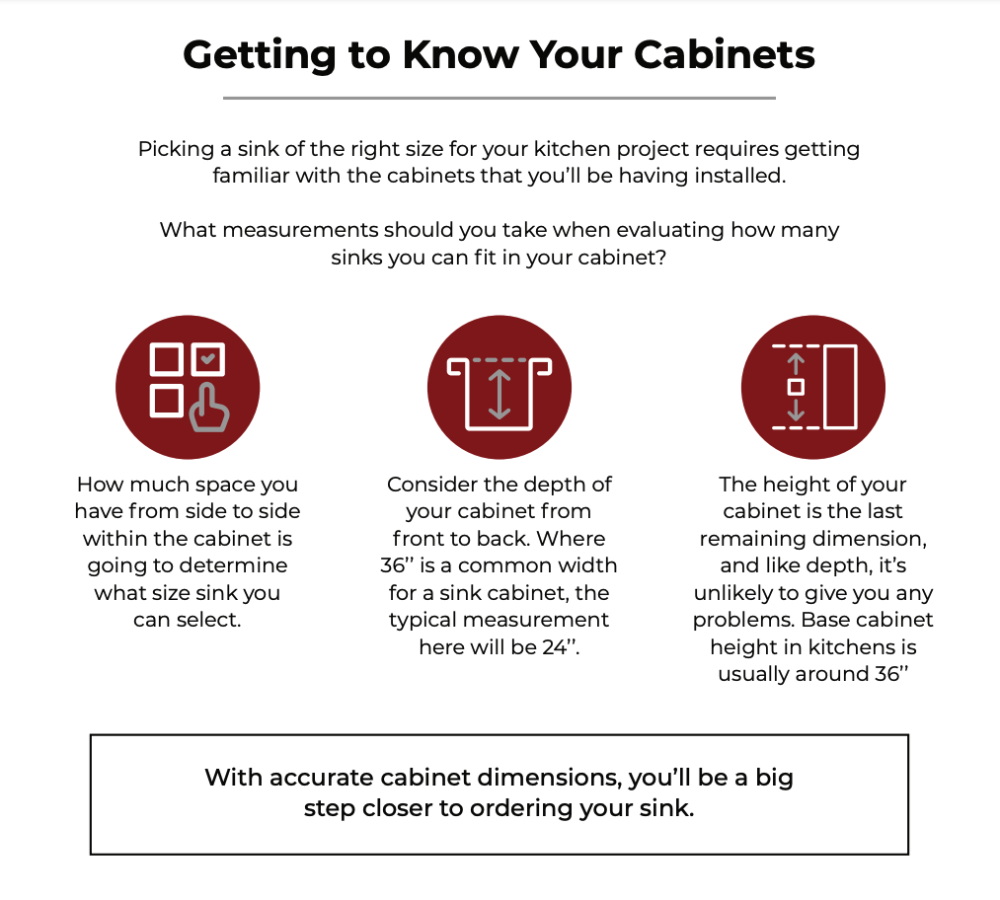
- This is the big one. How much space you have from side to side within the cabinet is going to determine what size sink you can select. Commonly, a base cabinet designed to hold a kitchen sink will be 36’’ wide, but you certainly can’t count on that being the case for your situation. If you already have the cabinets in place – or maybe they have been delivered but not installed – take a moment to physically measure the cabinet and confirm its size. If not, look at your order sheet or the plans for your kitchen to determine how wide it will be when it arrives. We’ll talk more in a bit about how the limits on sink size relative to cabinet width will vary depending on what type of sink you purchase.
- Although less of a factor than width, it’s also worthwhile to consider the depth of your cabinet from front to back. Where 36’’ is a common width for a sink cabinet, the typical measurement here is going to be 24’’. You should have roughly 24’’ from front to back to work with, which will be enough space for any standard sink. It’s unlikely that you run into trouble with this dimension, but it’s good to double-check just in case.
- Finally, the height of your cabinet is the last remaining dimension, and like depth, it’s unlikely to give you any problems. Base cabinet height in kitchens is usually around 36’’, meaning there is plenty of space under the counter for the sink to hang down. As mentioned earlier, if you are replacing an old sink with one that is deeper or shallower than the original, it will be necessary to make some plumbing adjustments to accommodate that change. For a new cabinet and sink installation, however, that won’t be an issue and the plumbing will simply be installed appropriately based on the depth of the sink basin.
It's important to note that you should determine how much interior space is actually available in your base cabinet, as this will vary depending on the thickness of the material used to build the cabinet. For instance, a cabinet that is nominally 36’’ wide will only have 34.5’’ of space available on the inside if 3/4’’ material was used (the 3/4’’ material on each side totals 1.5’’, which is subtracted from the 36’’ to get 34.5’’ of available space). If your cabinets were built using 1/2’’ material, you’ll have slightly more space on the inside to work with. Again, taking physical measurements is always best, but you should be able to get to the bottom of this by looking at the specs of your cabinets if they are not installed just yet.
With accurate cabinet dimensions in hand, you’ll be a big step closer to ordering your sink. So, what’s next? Now is the time to look at actual sink dimensions for products that you like and would consider adding to your home.
How Sinks Are Measured
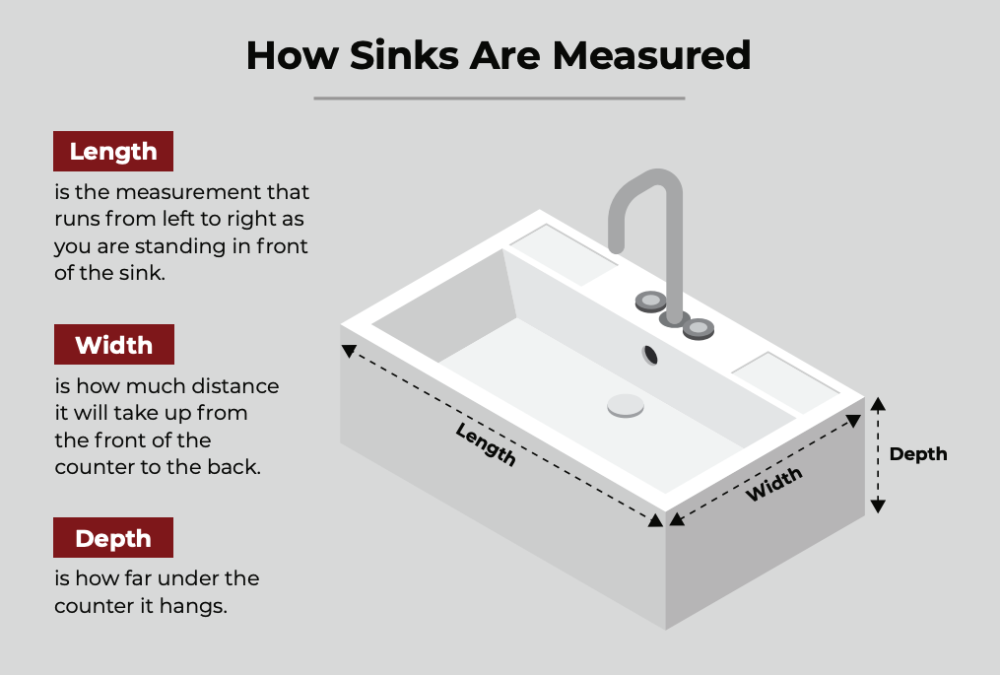
As with cabinets, there are a few different dimensions to consider when buying a sink. To make this clear and help you understand what to look for when shopping for your own sink, let’s walk through an example of an undermount sink with a single bowl. Our sample sink is listed with dimensions of 32’’ long, 19’’ wide, and 10’’ deep. So, what does that mean exactly? It’s pretty simple when you break it down –
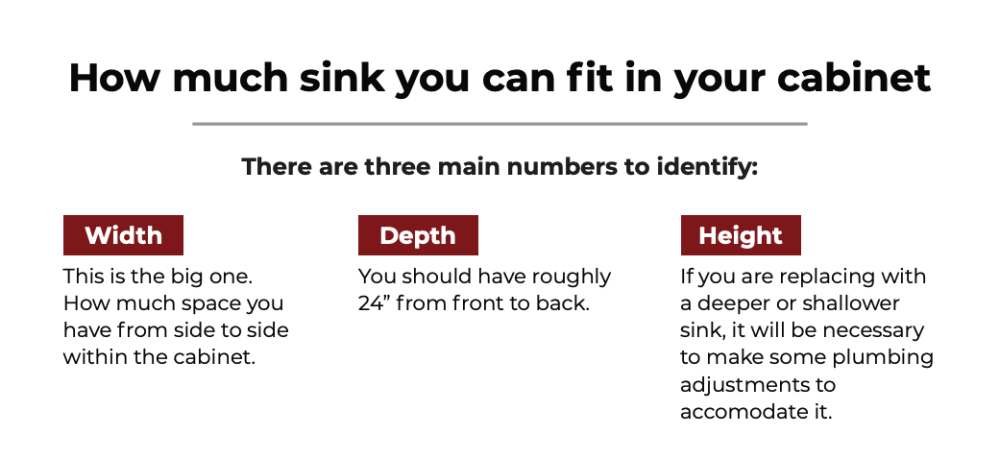
- The “length” actually looks like the width once the sink is installed, as this is the measurement that runs from left to right as you are standing in front of the sink. So, a sink that is 32’’ long means it will run for 32’’ from left to right within your cabinet.
- The width of the sink – 19’’, in this case – is how much distance it will take up from the front of the counter to the back. So, in a standard 25.5’’ kitchen counter, the sink will take up 19’’ and leave 6.5’’ to be split between the front and the back of the sink after it is installed.
- When talking about depth for a sink, we are talking about how far under the counter it hangs. This is a model on the deeper side, with a 10’’ depth, but that won’t pose any problems in most settings.
It’s at this point that we need to confront one of the points that can be confusing when purchasing a sink. As you look at the dimensions, the overall sink dimensions should represent the total length of the product from one end to the other, including the rim. That’s a big distinction and one you need to confirm before ordering. Are the dimensions you are looking at including the rim of the sink, or not?
Most of the time, you’ll see it listed as “sink dimensions”, and that should include the rim. There may also be a separate line for “bowl dimensions” which will tell you how big the bowl is once the rim is taken out of the equation. In the case of our sample sink, the bowl itself is 30’’ long, and an inch on each end is added for the lip to get to the total length of 32’’.
As a helpful guideline, you’ll often see a note included with copper sinks for sale that highlights how big the cabinet should be that is going to hold the sink. For this sink in our example, the manufacturer recommends that the base cabinet is no smaller than 36’’. This makes sense, of course, as that will provide enough room for not only the bowl of the sink but also the rim (that is going to be undermounted), along with just a bit of space on each side so the sink is not rubbing up against the cabinet itself.
Frequently Asked Questions About Sink Size
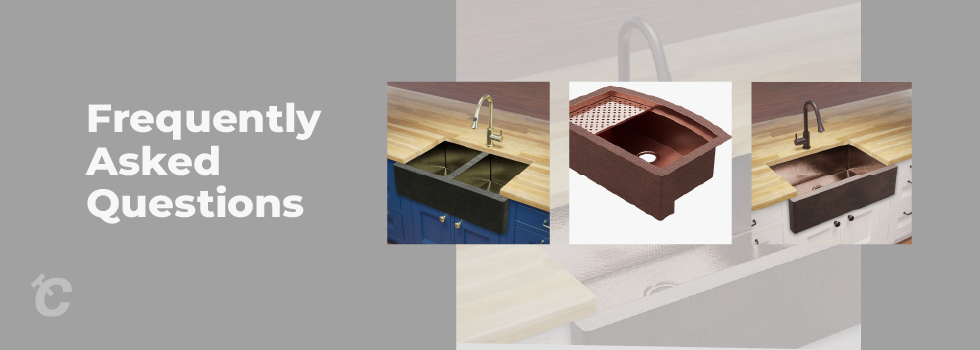
Hopefully, the explanations that we have provided so far regarding the measurements of your kitchen cabinet and the sink you’ll purchase have helped clear things up. At this point, we’d like to dive into some FAQs on the subject of sink size. Reading through these questions and answers may help you understand anything that is still confusing.
Q: What size sink should I buy for a 36’’ cabinet?
A: When shopping for a sink to put into a 36’’ cabinet, you will probably want to look at sinks that are marketed as 33’’ models. That will allow for enough room to mount the sink properly – whether it is a drop-in or undermount model – without having to cut into the sides of the cabinet to make space. Of course, you are not required to go with a sink that big, and you may decide to downsize to something like a 30’’ sink to preserve some extra counter space.
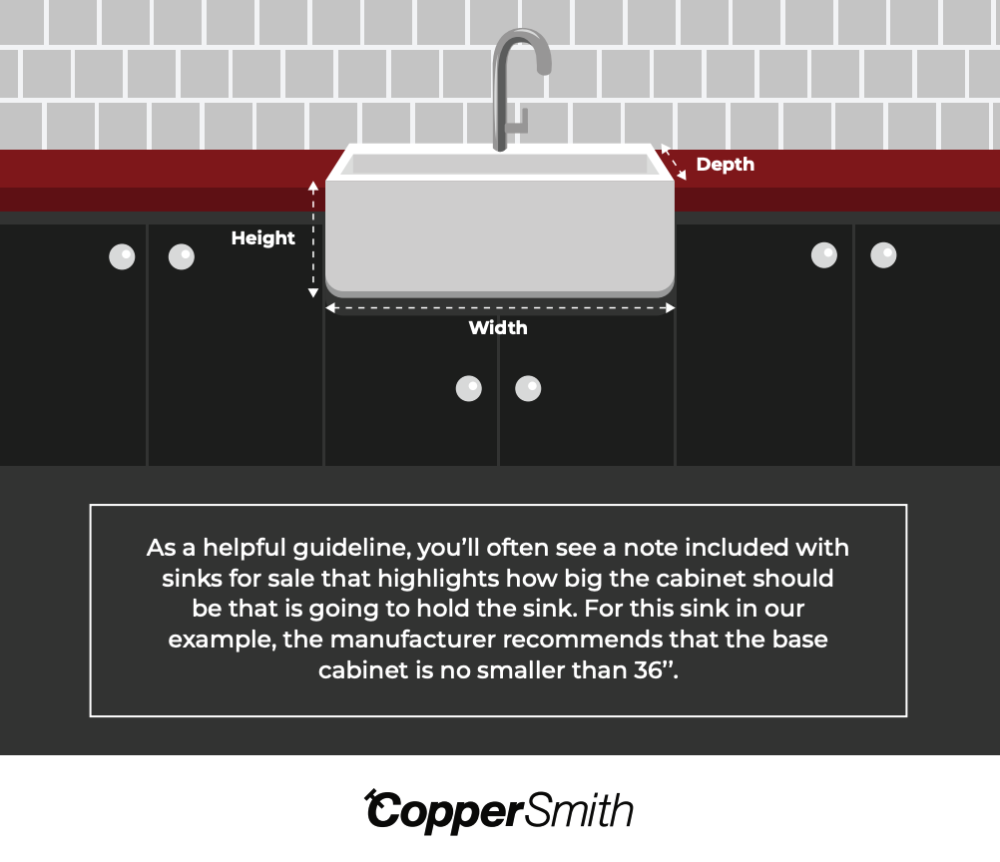
Q: Is it possible to go beyond the width of my cabinet to install a bigger sink?
A: In some cases, it would be possible to notch out the sides of a cabinet to make space for a larger sink. However, this method comes with some pretty notable drawbacks, so it’s probably best to find another solution. When you cut into your cabinets, you’ll be voiding any warranty coverage that may be in place, and you will somewhat weaken the structure of the cabinets as a whole. Also, if you cut into adjacent cabinets as a result, you’ll lose storage space and you might not like the look of what you’ve done when seen from the other side. Finally, if your dishwasher is adjacent to your sink cabinet, which is often the case, you won’t be able to cut in on that side because the dishwasher itself will be in the way. The appeal of a bigger sink is easy to understand, but it’s likely best to keep it within the confines of your cabinet’s dimensions.
Q: Should I buy an extra-deep sink?
A: When you pick a sink that is deeper than standard, say 10’’ rather than 8’’, you’ll find that there are some pros and cons associated with that choice. On the positive side, you will have more room in the sink, meaning you could add more water for washing dishes and you’ll have space to fill up larger pots, etc. It’s easy to see the appeal of having more total volume in your sink. With that said, don’t forget that you will forever be reaching all the way down to the bottom of the sink anytime you need to grab something that has been set inside. So, if you put a few plates and utensils in the sink after dinner, you’ll have to get them out of the bottom when it’s time to clean up. That might be easy if you are on the shorter side, but taller people will find that reach to be rather awkward. Also, remember that the depth of an undermount sink isn’t going to start until the bottom of the counter, so such a sink will feel even deeper than its true measurement.
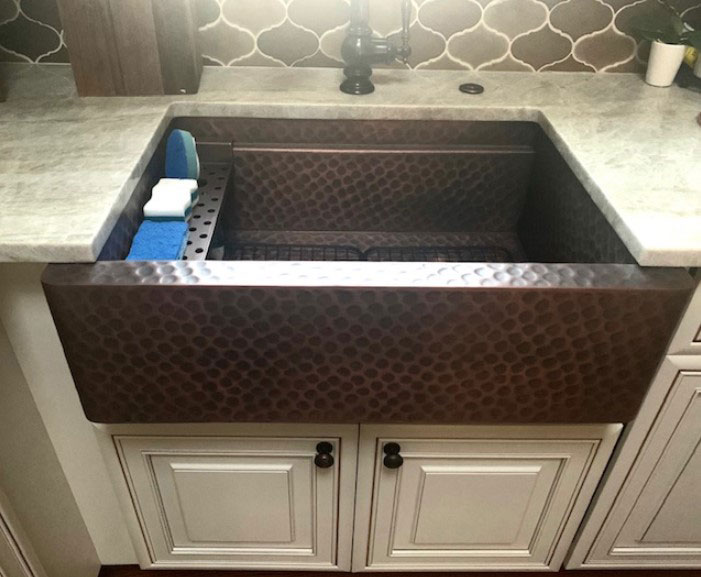
Q: Do I need to consider the garbage disposal when measuring for a sink?
A: In a word, yes, it’s a good idea to think about the garbage disposal when buying a sink, although it’s unlikely to be a problem in most cases. The garbage disposal, if one is used, will be mounted to the underside of the sink and will hang down into the cabinet. There is typically more than enough space for the disposal, even under a deep sink. However, if you have an unusually short cabinet height, you may want to measure based on the size of the disposal you plan to use and the depth of the sink you are going to purchase. Also, even if there is technically enough space for the disposal, you’ll want to consider how much storage room you lose under the sink if you go with a deep bowl. A deep copper sink combined with a large disposal will leave minimal room in the middle of the cabinet, which may or may not be a negative in your mind. You should also consider a new range hood or custom vent hood for your kitchen.
What are the pros and cons of having a deeper sink?
Some kitchen sinks are deeper than others. Depending on the length and the width of the sink, having extra depth can make washing large pots much easier. This is of particular help to those with big families or who host large numbers of guests for big meals. Another advantage is that if your kitchen sink is visible from other areas of the home, it is easier to hide the dirty dishes and pots!
However, ergonomically, they may not always be practical. They can be back-breaking. If someone who is six feet or so tall is washing the dishes, they already have to bend over quite significantly to reach the bottom of a normal depth sink. Add a couple more inches to that, and it can be really uncomfortable - although it is a great excuse for getting out of doing the dishes! For shorter people, though, this extra depth is generally not a problem. In fact, it can be easier. Look a the height of the people who will be using the sink before making a decision.
Best sink sizes for smaller kitchens
American houses are generally getting smaller, but this does not mean your choice of sink has to be limited.
If you have a compact kitchen, why not look for a drainboard sink with a removable chopping board? Many come with added drying attachments, which are perfect if your tiny kitchen space does not have the room for a dishwasher.
Most styles of sink work in small kitchens, as long as the sink is roughly between 22 and 24 inches. Anything more than 27 inches runs the risk of being too big and overpowering your kitchen, as well as taking up valuable counter space.
As you have less space, a single bowl sink may be the better option. If you wanted a double bowl, you would need to have smaller basins, and this can be overcrowded and not give yu enough room.
Sinks in kitchenettes
Some homes, such as old studio apartments, are just too small for even the smallest sink. As frustrating as this can be, you can look at prep or bar sinks. These are around 15 inches long, so are very small, and dishes can pile up quickly, but this is something you may need to consider if your kitchen just doesn’t have the space. If you can, go for the deepest sink bowl possible.
Wall-mounted sinks
Another option for people who are living with small kitchens is wall-mounted sinks. These sinks, as the name suggests, simply mount onto the wall and take up little space, requiring no space on your counter. They work brilliantly in lofts with open layouts or studio apartments, although you may need to purchase other kitchen parts such as freestanding kitchen storage and counters. They also require additional plumbing fixtures and professional installation.
Round sinks
While round sinks are pretty normal for bathrooms, the majority of kitchen sinks are square or rectangular. They do not have to be, however. Circular or oval shaped sinks take up less space on a counter and give you more room for faucets.
Corner sinks
This is a pretty uncommon style of sink, but one that could be just what you are looking for if you have a small kitchen. A corner sink has two sink basins forming a right angle, but is technically just a double bowl sink. These are most commonly found in homes with rectangular or square kitchen islands and bars, as well as in commercial kitchens. They fit into the corner, which is often an underused space, and save a lot more counter space than traditional large double-bowl sinks. If you host a lot of people or have a large family but don’t want a big sink, this could be worth looking into.
Accessorize
Once you have chosen the right sink size for your cabinet, it is time to choose the sink accessories that will help to add workspace and functionality. Soap can be kept in reach with a sleek soap dispenser. Cutting boards can be added to your sinks from CopperSmith - they can rest across the sink. Strainers and drying boards can also help to add additional functionality to your sink.






